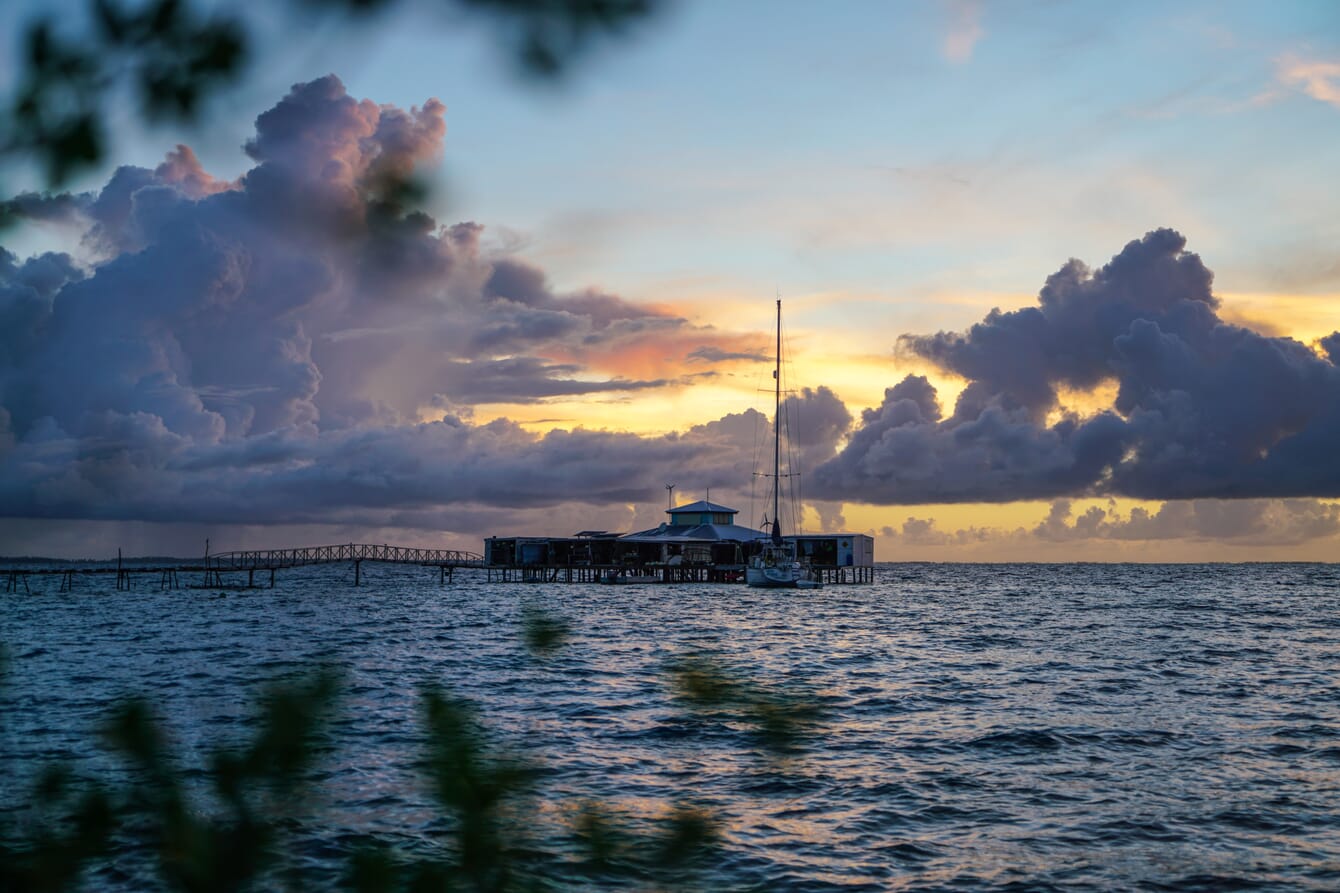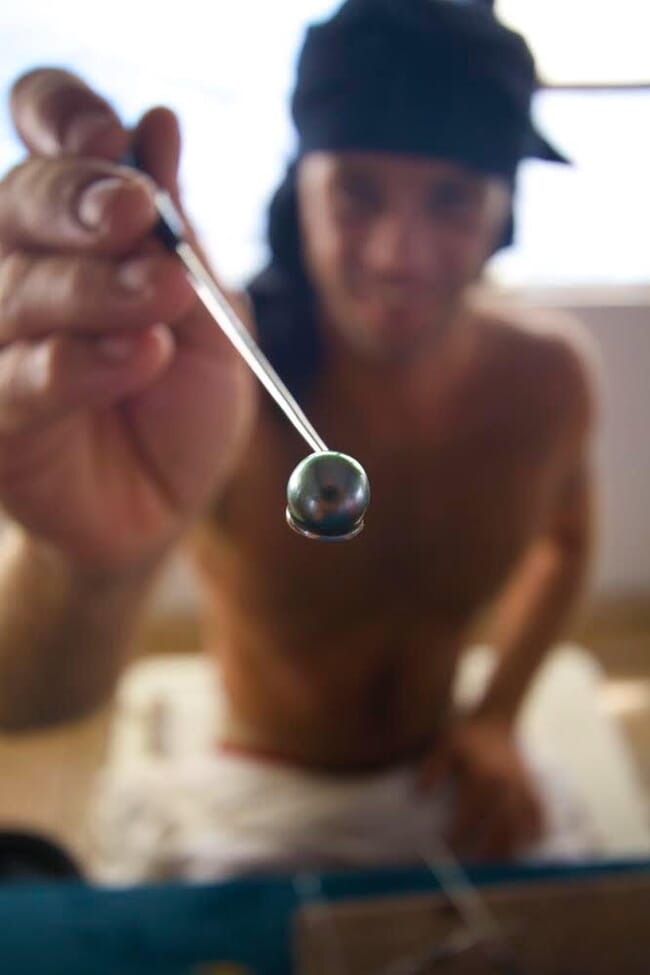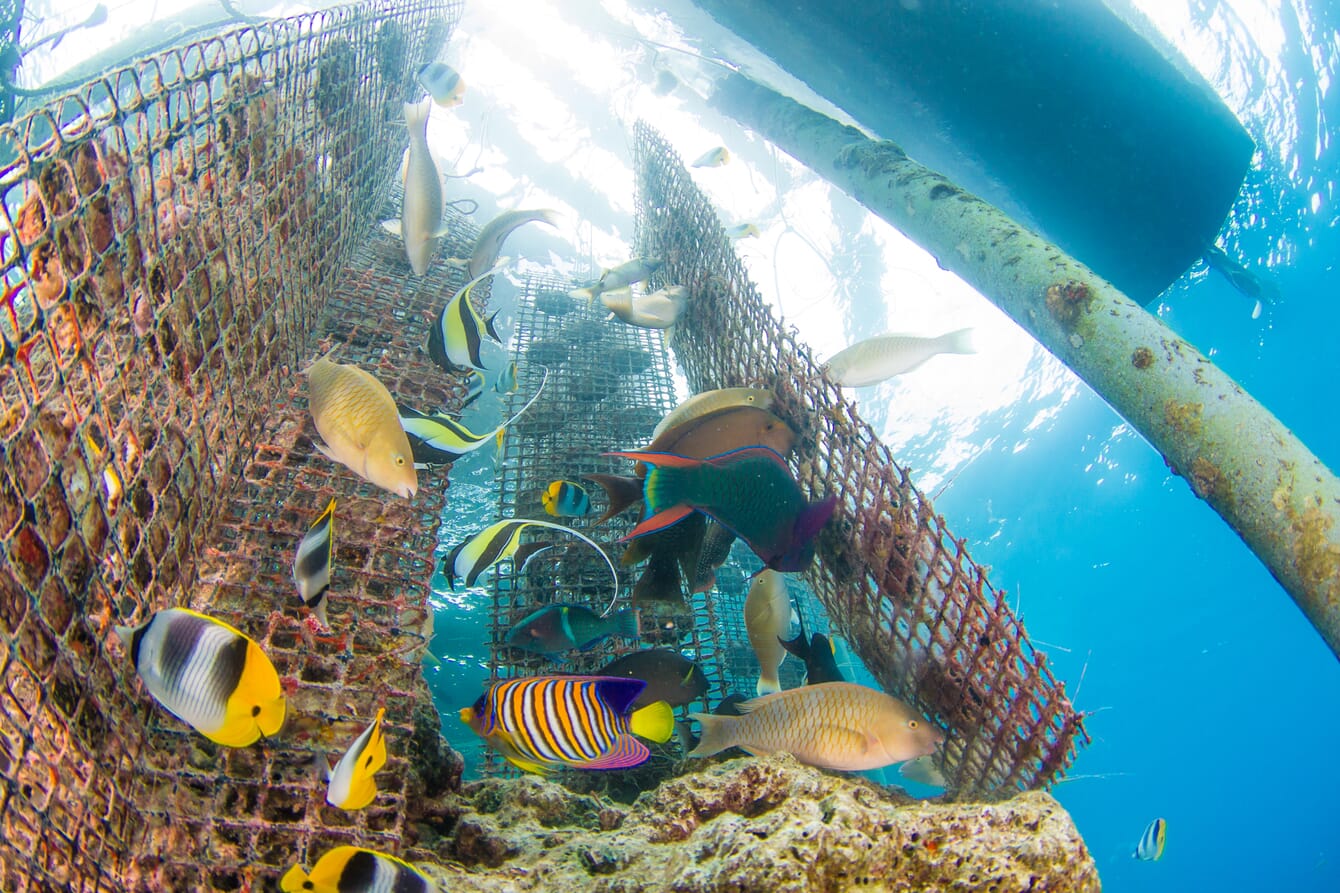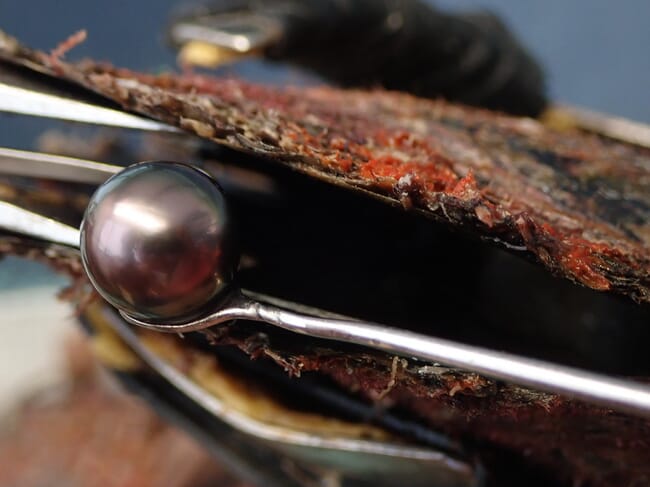
Ahe, where the farm is located, is a coral atoll in the northern Tuamotu Archipelago and has a land area of approximately 12 km² © Kamoka Pearl
Built by three generations of the same family, through innovations in oyster cleaning and reef management, Kamoka demonstrates how small-scale farms can improve productivity while supporting marine biodiversity.
A legacy born from the sea
Kamoka Pearl Farm was founded by Patrick Humbert, a French national who moved to California in the 1970s. With a background in carpentry, he taught himself to build and sail a boat, eventually crossing the Pacific with his wife, children and two dogs.
“He had a dream of sailing the world,” explains Tevai Humbert, Patrick’s grandson and current CEO of Kamoka. “He didn’t really know anything about building boats or sailing, so he pretty much just started teaching himself.”
After arriving in French Polynesia, the family settled in Ahé, the remote atoll that would later become host to the pearl farm. Following a separation from his wife – who returned to the US with their children – Patrick chose to stay on the atoll where he became close to the locals.
‘’One cool story, just to put it in perspective, is he converted his sailboat into a fridge with a compressor. The reason he did that was to bring all the fish from the locals in Ahé – as there’s just so much fish on the atoll – all the way to Tahiti. Then, he would sell the fish on the local market and bring all the resources back to Ahé,’’ says Tevai.
After an accident on one of his voyages, Patrick ended up returning to the USA. Before he left, a local woman promised to keep and gift him some land for him upon his return. Two decades later, she had kept that promise. This land is now the site of Kamoka Pearl Farm.
The birth of Kamoka
Patrick returned to the atoll and began building the pearl farm with his son Loic. A year later, his second son, Josh, joined them to help complete the farm and make it functional. One of the key skills he had to master was grafting - the process of inserting a small piece of donor mantle tissue and a nucleus into a host oyster to stimulate the formation of a cultured pearl - and Josh was taught to graft by Japanese grafters – pioneers in cultured pearl production – and has since trained a dozen of other grafters himself.

© Kamoka Pearl
Kamoka pearl farm specialises in the culture of the native black-lipped oyster (Pinctada margaritifera). In the early years, pearl prices were at their highest, often worth more than gold. This led to a big gold rush in the pearl industry, all around French Polynesia. At its peak, the farm employed around 20 people, but as the market became saturated, the farm dropped down to one employee.
‘’We had actually moved. The price crashed a lot which put most farms out of business and did a lot of damage to us. My parents wanted me and my sister to go to school in the States, it was kind of a struggle for them to make ends meet here, just because of the market and the farm situation,’’ says Tevai.
Tevai joined the farm full-time five years ago, identifying a key gap in the operation.
‘’We had the farm, the brand was there, we had a killer story - everybody that had come through or that heard about the story were all super excited about it and they loved it. But we were doing no marketing whatsoever, we weren't telling the story at all.’’
At the time, the only digital presence was an Instagram account with 4,000 followers and a National Geographic article. Being younger and more social-media oriented, Tevai started making videos and sharing them on platforms like YouTube and TikTok. And they now have had over 4 billion views combined across the different platforms.
‘’We've now reached a point where our story and our pearl farming process really resonates with a lot of people,‘’ explains Tevai.
After being stagnant for a long time, this boost has permitted the farm to start growing again – a new employee was hired in response to the fivefold increase in production they planned this past year.

© Kamoka Pearl
Sustainable innovation in pearl farming
Kamoka Pearl Farm has developed a fish-assisted oyster cleaning technique that offers an alternative to conventional pressure washing. In conventional pressure washing, farmers wash their oysters in the lagoon and release biofouling into the water column. This practice can lead to higher parasite loads and disease outbreaks, particularly in larger farming operations.
Initially, the Humbert family used the same methods, unaware of the long-term environmental risks. Once it became clear that this was harming the lagoon ecosystem, the inhabitants of the atoll made a local agreement to stop pressure washing in the lagoon.
‘’Now most people pressure wash on land – which is fine – but we decided to go a different way, and we started using fish to clean our oysters instead,’’ says Tevai.
To optimise pearl quality, Kamoka hangs its oysters in the deeper channel where water quality is more stable. However, as they are too deep for reef fish to venture there, Kamoka brings the baskets in the shallows near their platform every two months. There, baskets are opened, allowing reef fish to enter and clean the structure and oysters. Although this method is more time-consuming, it has significantly increased local fish populations around the farm site.

© Kamoka Pearl
‘’I don't have the exact numbers but if you go to our farm and compare it to other places on the atoll, it's probably five times more fish in our area. The oysters just provide such an abundance of food to all these local fish, so they know to hang around there and they know they're safe around our area because we don't fish in our pearl farming area at all. There is actually a lot of people that will come and fish right outside of our boundaries, just because they know that Kamoka has a lot of fish,’’ explains Tevai.
In addition to supporting local biodiversity, Tahitian pearl oysters offer further sustainability advantages. Like South Sea oysters, they can be grafted and reseeded multiple times, reducing the need for constant new stock.
Challenges of remoteness and resilience
Operating a pearl farm on a remote Pacific atoll presents a unique set of logistical and environmental challenges: basic materials, supplies and food must be shipped from Tahiti, often arriving just once a week.
‘’The benefit is just being at peace, you know – not having to deal with the outside noise – but it definitely comes at a cost. I can't just go to Home Depot. If we want stuff, we have to order it from Tahiti and then it comes on a boat once a week, including construction material,’’ explains Tevai.

© Kamoka Pearl
In 2024, transport disruptions caused further strain. Supply boats broke down multiple times, including one incident where no shipments arrived for over two months. These delays forced the team at Kamoka and other local farmers to rely heavily on improvisation and DIY approaches, adding complexity to day-to-day operations.
Climate-related risks are also increasing. With the atoll only a few metres above sea level, rising ocean levels are an ongoing concern. At the same time, changes in local marine ecosystems are contributing to a rise in oyster predation from species like titan triggerfish, rays and turtles. In one instance, predators destroyed 10,000 oysters.
‘’Before, we didn't have to use baskets for oysters at all because we didn't really have a predation issue. There are actually some parts of French Polynesia that still don't need to use our types of baskets,’’ explains Tevai. ‘’They just become bigger and bigger every year. If you want to get the world record trigger fish, it's definitely the Tuamotus.’’
Financially, Kamoka has also been impacted by the wider crash in the pearl industry. Over the last few years, the objective was to pay off debt – a target they have now achieved, creating room for innovation and refurbishment.
‘’We would work for free and we definitely developed a lot of debt over time. That was scary and that definitely wasn't sustainable. I think if we didn't go the path that we've gone now, the farm probably wouldn't be around today. A lot of the farm fell apart, and it's still falling apart right now. We have a lot of work to do on the rebuild and farm,’’ says Tevai.

© Kamoka Pearl
Always improving the farming system
At Kamoka, trial and error has been essential to refining their methods, particularly since it takes three to four years for an oyster to produce its first pearl. Always seeking to improve their systems, they now have some new ideas.
‘’One milestone we have achieved right now is we've developed a system where we pretty much are cutting our labour needs by 50 percent. That has been the most revolutionary thing for us,’’ explains Tevai, before diving into the details of this new system.
Kamoka is trialling a fish-assisted cleaning method that positions oysters in close proximity to the reef, forming an artificial structure that encourages fish to clean in deeper water. By leaving baskets open and strategically placing the first oysters to block access for predators like triggerfish, the cleaning process can be continuous, without needing to bring baskets into the shallows. This reduces labour requirements while maintaining ideal water conditions.
‘’They're growing about 30 percent faster. Pearls are the same size at eight months as they would be at 12 months. They never get dirty, so they're always just healthy and doing good. We have also noticed a much higher amount of round pearls, which are worth more and are more sought after, with better colour and lustre,’’ says Tevai.
Alongside this, the team has been refining its natural oyster collector systems. Kamoka avoids using hatcheries, relying exclusively on wild spat collection in an effort to keep operations as close to nature as possible – both for the health of the oysters and the surrounding ecosystem.
Looking ahead, Tevai is focused on scaling impact rather than production. Instead of expanding Kamoka, he plans to support smaller family-run farms by sharing Kamoka’s methods and offering to buy pearls at higher prices than industrial buyers. This approach would allow the farm to remain small but connected, supporting local livelihoods while maintaining ecological standards.
‘’Consumers are getting their pearls from a place that's really trying – we’re definitely not perfect in any way – but at least we're trying to do the right thing. We're trying to make things better in our local environment,’’ concludes Tevai.

A greater crested tern (Thalasseus bergii) rests on the narrow walkway linking the farm to the atoll © Kamoka Pearl




